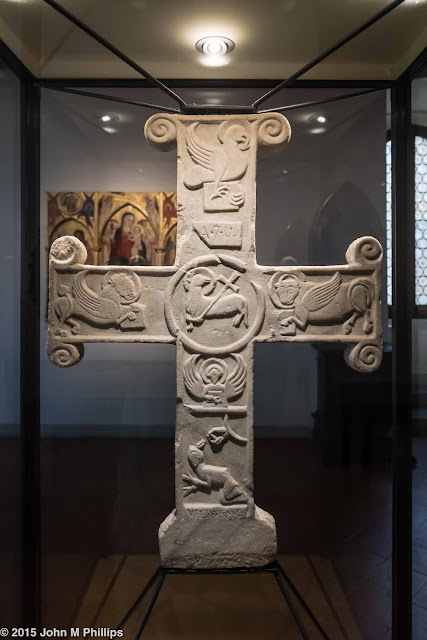Because of its history, the town is the site and source of numerous Etruscan artifacts and the home to an outstanding Etruscan museum. This museum is a real gem and anyone who visits Cortona should plan to visit it. Not only are the artifacts interesting and important from an archeological perspective, but the museum does a great job of presenting them. Here is some of what I shot during our tour.
Many of the artifacts consist of pottery, which was surprisingly well preserved and aesthetically pleasing, as in the following shots.
I confess to liking the following shot in part because I was able to catch the shadow of one of the animal figures on the wall behind.
I also liked the pleasing design carved into a stone slab in the following photo.
One of the most interesting and significant exhibits was of some copper plates that were found in a farm field relatively recently.
Here is a closeup.
Although our tour guide didn't seem to know the meaning of the Etruscan script found on these plates, I later learned that the plates had a relatively mundane commercial significance.
Here is one of several figurines displayed in the museum, which caught my eye because it was literally two-faced.
During the tour, our guide directed our attention to what apparently is considered the most important, most valuable of the museum's exhibits, a massive bronze chandelier. Important and valuable it may have been, but it was exceptionally unphotogenic, and I found myself discarding the couple of shots of it that I took.
The museum was primarily devoted to Etruscan artifacts, but it also included more recent, Christian-themed works, including the following beautifully rendered stone cross.
Our group was also intrigued by the following painting done by Luca Signorelli in 1512.
This circular work was interesting for a number of reasons. While the subject matter of Madonna and Child is a common one, what about the figure with the scales to the left? Was someone weighed the balance and found wanting (ala Daniel and Belshazzar)? And why are the Madonna's feet resting on the heads of babies or cherubs? Then there is the matter of the figure in the lower left who obviously is righteousness challenged. Here is a closeup of that guy.
Finally, on our way out I noticed how a wrought iron lattice was creating shadows on the polished tile floor and took the following shot that I converted to a black & white..
Just me trying to be artistic.
John












No comments:
Post a Comment
Note: Only a member of this blog may post a comment.